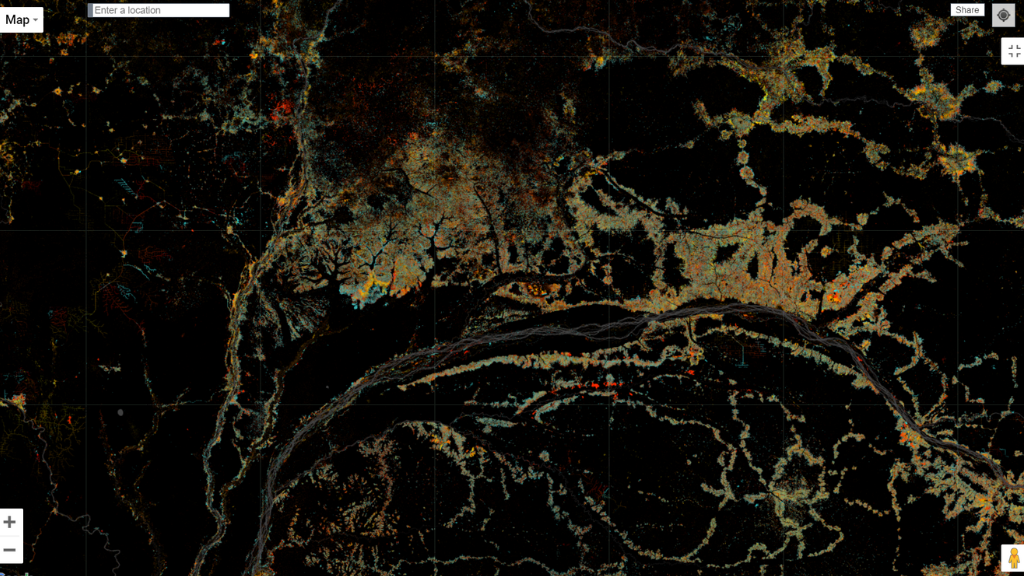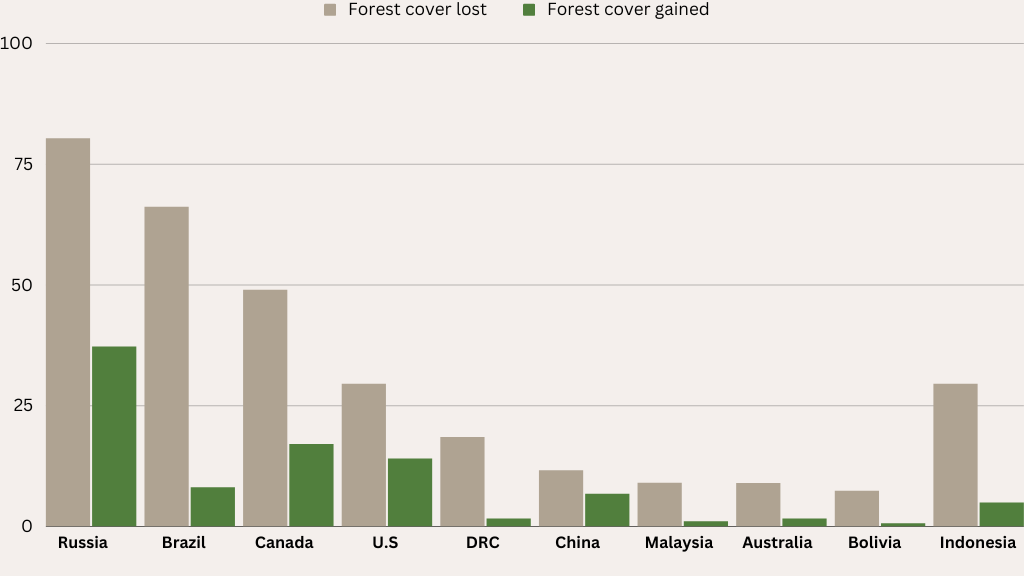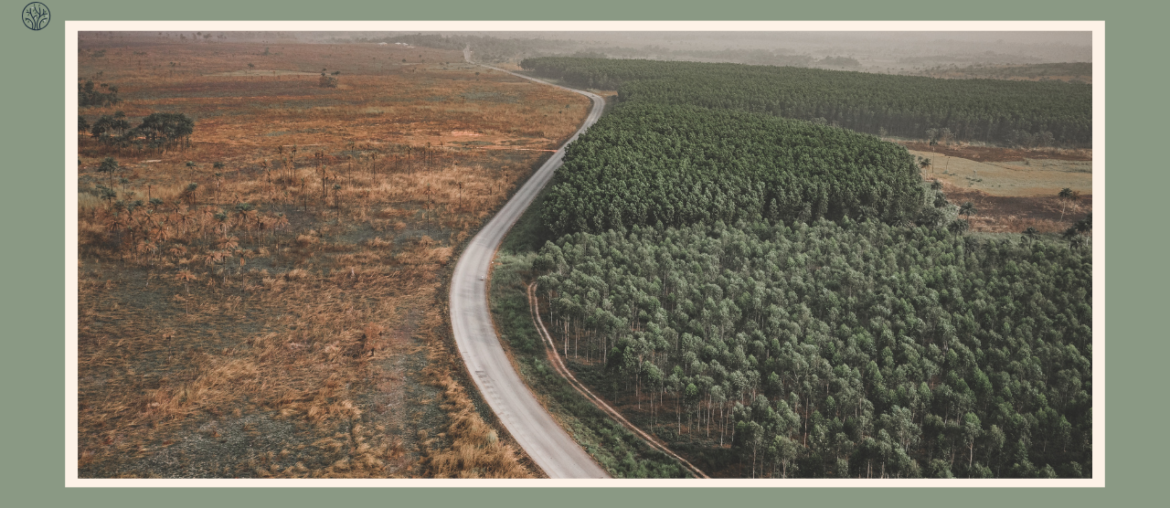Deforestation is the permanent removal of trees from a forested area. This usually happens due to human activities such as agriculture, logging, mining, or urban development. But where is deforestation the worst? Which countries have the highest rates of forest loss and degradation? And what are the main drivers and causes of deforestation in different regions of the world?
Which Country Has The Most Deforestation?
According to the FAO, between 1990 and 2020, the world lost about 178 million hectares of forest area. The global rate of deforestation has decreased in recent decades, but it is still alarmingly high in the tropics.
The FAO estimates that Brazil had the largest net loss of forest area in the world, with an average annual loss of 1.5 million hectares.
The main driver of deforestation in Brazil is cattle ranching, which accounts for about 80% of the cleared land in the Amazon. Other drivers include soybean cultivation, logging, mining, infrastructure development, and fires. The current government has been criticized for weakening environmental policies and, encouraging land grabbing and illegal activities.
According to GFW, Brazil had the highest amount of tree cover loss in 2020, with 1.7 million hectares lost. This was a 25% increase from 2019 and the highest level since 2016.
Other countries with high amounts of tree cover loss in 2020 include the Democratic Republic of Congo (DRC), Russia, Bolivia, Indonesia, Peru, Malaysia, Colombia, Angola, and Myanmar.
Deforestation Rates by Country
Another way to measure deforestation is by looking at the percentage change in forest area over time. This can indicate how fast a country is losing or gaining forest cover relative to its initial forest area.
According to this data, the country with the highest rate of deforestation between 2010 and 2020 was Comoros. The country lost 21.5% of its forest area in this period, equivalent to about 14 thousand hectares. The main causes of deforestation in Comoros are slash-and-burn agriculture, charcoal production, population growth, and land tenure insecurity.
Other countries with high rates of deforestation between 2010 and 2020 include Burundi (17%), Nicaragua (15.7%), Cambodia (14.6%), Liberia (13%), Guinea-Bissau (12.8%), Benin (12%), Togo (11.8%), Nigeria (11%), and Haiti (10%).
On the other hand, some countries have managed to increase their forest area over time through natural regeneration or afforestation. The country with the highest rate of forest expansion between 2010 and 2020 was China. China’s total forest area increased in this period was 9% (~ 22 million hectares). To achieve this, China has implemented large-scale afforestation programs since the late 1970s to combat desertification.
Other countries with high rates of forest expansion between 2010 and 2020 include Chile (8.9%), Turkey (8.6%), Spain (7.4%), France (7.1%), Italy (6.9%), Vietnam (6.8%), India (5.9%), Cuba (5.8%), and Bhutan (5.6%).
Where Does Deforestation Occur The Most?
Deforestation is not evenly distributed across the world. It tends to occur more in certain regions, depending on the natural and human factors that affect forests.
Map
One way to visualize the distribution of deforestation is by using maps that show the forest loss and gain over time.
One such map is the Global Forest Change map. This map uses satellite imagery and algorithms to detect changes in tree cover. Using the map, we can see how much tree cover loss or gain occurred in each year, as well as the total change over the entire period.

According to this map, deforestation occurs the most in the tropics, especially in South America, Central Africa, and Southeast Asia. These regions contain some of the most diverse and valuable forests in the world, such as the Amazon, the Congo Basin, and the Indonesian archipelago.
Deforestation Chart
Another way to visualize deforestation is by using charts. By looking at the chart, we can compare different countries or regions in terms of net forest change.
One such chart is the FAO Global Forest Resources Assessment 2020 Dashboard. This chart provides data on forest resources and management for every country in the world from 1990 to 2020.
For example, using the dashboard, we can create a chart that shows the net change in forest area for the top 10 countries with the highest net loss or gain between 2010 and 2020.

The chart shows that Brazil had the highest net loss of forest area in this period (-15 million hectares), followed by Indonesia (-4.4 million hectares), Myanmar (-3 million hectares), Nigeria (-2.7 million hectares), and Tanzania (-2 million hectares). The chart also shows that China had the highest net gain of forest area in this period (+22 million hectares), followed by India (+5 million hectares), Vietnam (+3 million hectares), Turkey (+2.8 million hectares), and Chile (+2.6 million hectares).
Deforestation Rates by Year
Another indicator of deforestation is the annual rate of change in forest area. This measures how fast a country or region is losing or gaining forest cover in a given year.
The FAO data shows that the global annual rate of change in forest area has decreased from -0.18% per year in 1990-2000 to -0.1% per year in 2010-2020. This means that the world is losing less forest area per year than before, but it is still losing more than it is gaining.
The data also shows that different regions have different trends and levels of annual rate of change in forest area. For example, Africa had the highest annual rate of net loss of forest area, followed by South America and Oceania. On the other hand, Asia had the highest annual rate of net gain of forest area, followed by Europe and North America.
Which African Country Is Losing Its Rainforest The Fastest?
Africa is home to about 17% of the world’s forests, covering about 674 million hectares. However, Africa also has the highest rate of deforestation in the world, at 3.9 million hectares.
Within Africa, the region with the most forest cover and the most forest loss is Central Africa. Unfortunately, this is home to the second-largest tropical rainforest in the world, the Congo Basin. The rainforest covers about 200 million hectares and spans 6 countries. Because of that, The Congo Basin is a hotspot of biodiversity, hosting more than 10,000 plant species, 1,000 bird species, and 400 mammal species, many of which are endemic and endangered.
According to GFW, the African country that is losing its rainforest the fastest is DRC. The country had the second-highest amount of tree cover loss in the world in 2020, with 1.1 million hectares. This was a 12% increase from 2019 and the highest level since 2016. The sixth most forested country in the world contains about 60% of the Congo Basin forest and has a forest cover of about 152 million hectares.
The main drivers of deforestation in DRC are small-scale agriculture, charcoal production, logging, mining, and conflict. About 80% of the population depends on forests for their livelihoods. However, due to weak forest laws and the protection of forest rights, the country faces pressure from foreign investors who seek to exploit its rich natural resources.
Other Threats
Forest Degradation
Deforestation is not the only threat to forests. Forest degradation is when the forest’s ecosystem is permanently damaged leaving the forest area intact but can’t provide any values. This process can result from logging, fire, diseases, climate change, or other human or natural disturbances.
Forest degradation can have significant impacts on the environment and society, such as reducing biodiversity, water quality, soil fertility, etc. Degraded forests are more fragmented, and flammable which can lead to other problems like forest fires or further deforestation.
Furthermore, forest degradation is more difficult to measure and monitor than deforestation. Since it involves subtle or gradual changes that can not be measured. Therefore, there is less data and information available on the extent and drivers of forest degradation than on deforestation.
According to a study between 2001 and 2019, the world lost about 386 million hectares of forest to degradation. This was more than the forest area lost to deforestation (361 million hectares) in the same period. The study also found that the region with the most forest degradation was South America (120 million hectares).
Tree Cover Loss and Global Warming
One of the consequences of deforestation and forest degradation is the loss of tree cover. Tree cover is important for the environment because trees absorb carbon dioxide from the atmosphere and store it in their biomass and soil. They also provide shade, regulate temperature, and influence precipitation and wind patterns.
When trees are cut down or burned, they release carbon dioxide back into the atmosphere, contributing to global warming and climate change. According to a report by the Global Carbon Project, land use change accounted for about 12% of the global greenhouse gas emissions in 2019. The report also estimated that the total carbon stock in living forest biomass decreased by 0.5 gigatons of carbon per year between 2010 and 2019.
According to GFW, the world lost about 4.2 million hectares of humid tropical primary forests in 2020. This was a 12% increase from 2019 and the third-highest annual loss since 2002. The countries with the most humid tropical primary forest loss in 2020 were Brazil (1.7 million hectares), DRC (0.5 million hectares), Bolivia (0.3 million hectares), Indonesia (0.3 million hectares), and Peru (0.2 million hectares).
The loss of humid tropical primary forests released about 2.64 gigatons of CO2 into the atmosphere. This amount of CO2 is equivalent to emissions of 570 million cars, more than double the number of cars in the United States. This means that deforestation and forest degradation not only reduce the capacity of forests to sequester carbon but also increase the sources of carbon emissions.
How to Stop Deforestation and Forest Degradation?
Deforestation and forest degradation are complex problems. The world needs to act together to stop these processes from increasing. Unfortunately, there is no one-size-fits-all approach. But some general strategies and actions that can help to conserve and restore forests include:
- Strengthening forest governance and law enforcement to prevent illegal activities that damage forests.
- Securing forest rights for people and local communities who depend on forests.
- Promoting sustainable forest management practices that balance environmental, social, and economic objectives and benefits.
- Expanding protected areas and creating ecological corridors to conserve biodiversity.
- Supporting forest restoration and reforestation initiatives.
- Reducing forest fires and controlling invasive species that degrade forests.
- Improving forest monitoring and reporting systems.
- Increasing public awareness and education on the value and importance of forests.
- Enhancing international cooperation and funding for forest conservation and restoration.
- Addressing the underlying causes and drivers of deforestation and forest degradation
Conclusion
Deforestation is one of the most serious environmental problems facing the world today. It has devastating effects on biodiversity, climate, water, soil, health, livelihoods, and culture. Deforestation is not evenly distributed worldwide, but it occurs more in certain regions and countries than in others. The main drivers of deforestation are agriculture, logging, mining, infrastructure development, and fires.
Forest degradation, on the other hand, is when forests are damaged to the point that they cannot provide any value to people and nature. This process can result from many human or natural disturbances.
This issue can be prevented or reversed by implementing solutions at local and global levels. These solutions, if done correctly, can help us not only save the forests but also fight climate change and create a more sustainable future for ourselves and generations to come.









